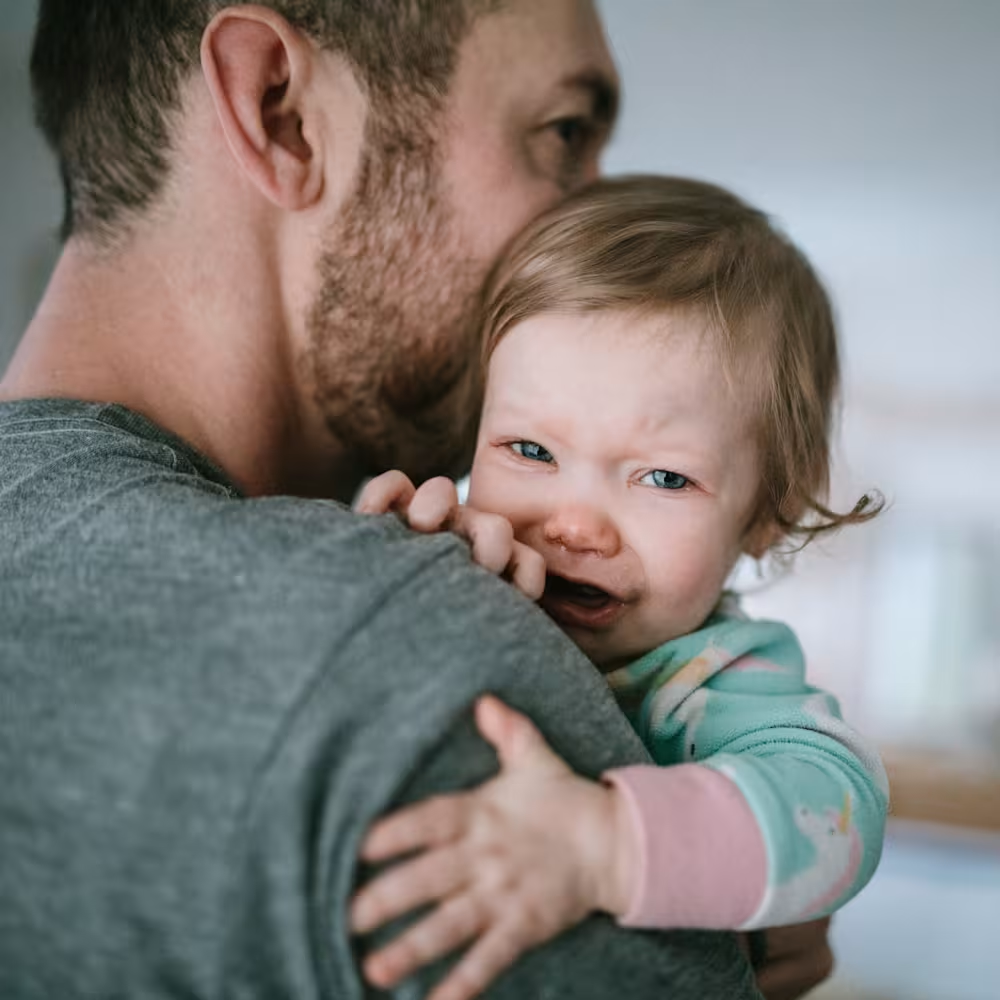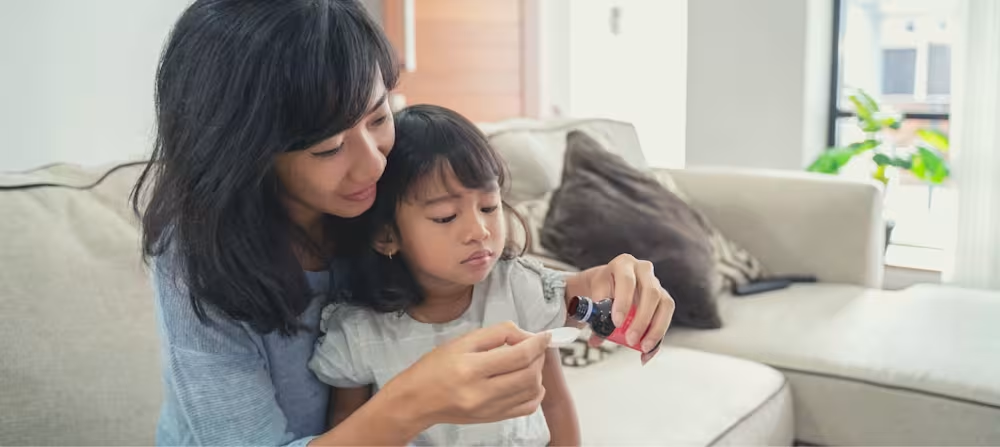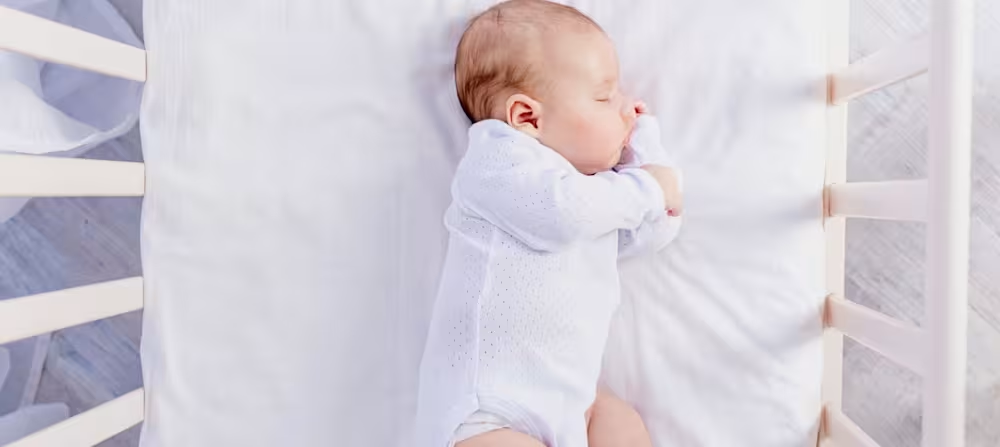How to help a baby sleep with a stuffy nose?
Updated Dec 29, 2025

It’s not easy for adults to sleep with a stuffy nose, so you can only imagine how tricky it is for little ones to get the rest they need when they’re congested. And since children are so prone to those sniffles, it’s normal to feel like your child is constantly snotty and not sleeping. Babies often get sick 6 - 8 times [] before they turn 1!
In this article, we’ll give you information on how to safely help your baby sleep when they have a stuffy nose, give you advice on ways to remove mucus and answer frequently asked questions about sick babies.
Table of Contents
What causes a stuffy nose in babies?
Stuffy noses happen when a baby’s nose tissues swell and produce mucus (aka snot). This is usually caused by one of the following:
Colds: Most babies will get sick 6 - 8 times [] during their first year! This is partly because children have immature immune systems [] and their upper airways aren’t fully developed until school age. Plus, kids aren’t the best at keeping their germs to themselves by covering their mouths when they cough and sneeze.
Irritants: Dust, smoke, perfumes, etc.
Dry air: Dry, cold air can cause nose tissue to become irritated [] and then produce more mucus, which increases congestion.
Fluid in a newborn’s nasal passage: A newborn may sound congested when sleeping in those early days after birth because they have leftover fluid in their nasal passages []. They may snort when they breathe or sneeze to get rid of the fluid.
How to tell if your baby has a stuffy nose
There are often some telltale signs that your baby is congested, such as:
Nasal discharge (thick or discolored nasal mucus)
Snoring or noisy breathing
Sniffling
Difficulty eating
Trouble sleeping
Presence of cold symptoms (cough, irritated throat, etc.)
What is the best sleeping position for a baby with a stuffy nose?
The best sleeping position for babies (with a stuffy nose or not) is on their back. The American Academy of Pediatrics (AAP) [] recommends always placing babies flat on their backs on a firm, flat sleep surface in accordance with safe sleep practices.
Elevating your little one up on a pillow or towel or raising one end of their crib mattress for sleep is not recommended. These tactics can make it harder for children to breathe [] because their necks may bend forward or fall to one side while inclined, restricting their narrow airways.
Letting your baby sleep in a swing or car seat is not recommended either (when sick or healthy) because they don’t offer enough support for safe sleep. If your child has fallen asleep in a car seat or other carrier, the AAP [] recommends moving them to a flat sleep surface as soon as possible.
It’s understandable that parents want to do anything they can to help their congested child sleep. Holding your little one for sleep is generally regarded as safe, as long as the caregiver is awake. Sleep-related infant deaths are up to 67 times [] more likely if a baby falls asleep with a caregiver on a soft surface, like an armchair or couch.
What should I do if my baby prefers sleeping on their stomach but has a stuffy nose?
The AAP recommends always placing your baby on their back to sleep. However, if your little one can roll both ways — back to tummy and tummy to back — you don’t need to reposition them every time they roll. If they appear more comfortable on their tummy, it’s OK to let them sleep! Make sure their sleep space is clear [] of blankets, pillows, stuffed toys, and bumper pads. These items pose a risk of blocking the baby's airway.
Sleep tips for a baby with stuffy nose
Children need plenty of rest when they’re under the weather, but it can be hard to know how to help a baby with a stuffy nose sleep. Snot and sniffles can make it tricky for little ones to fall asleep and stay asleep! Here are a couple of suggestions for helping your baby get some shuteye.
| Tip | Explanation |
|---|---|
| Try a cool-mist humidifier in the room or steam treatment before sleep times | Cool mist or steam can help clear stuffy noses |
| Use gentle suction and/or saline drops | Babies have a hard time clearing fluid and mucus on their own. Helping them do so can help them eat and sleep more comfortably |
| Ensure your little one is hydrated | Fluids can help thin mucus, which can lead to improved congestion and better sleep |
| Keep baby in an upright position longer than usual after they eat | This may help reduce spit-up due to congestion |
Tip #1: Use a cool-mist humidifier or steam treatment before sleep
A vaporizer or cool-mist humidifier in the room may help clear out congestion while your baby sleeps. The device should be placed close enough to your little one’s sleep space that the mist helps them, but should not be in reach of your child for safety reasons. Keep in mind that most of these machines require new water every day to function properly. Also, be sure to follow the manufacturer’s directions for cleaning and use to prevent bacteria and mold build-up.
Steam can help clear congestion too. For a quick, easy steam treatment before sleep times or when they’re extra stuffy, run hot water in the bathroom for a few minutes while keeping the door closed. Then take your baby in the room and snuggle them while they breathe in the steamy air. If your child becomes overheated or unhappy while doing a steam treatment, leave the room and try again another time.
Tip #2: Try gentle suction and/or saline drops
Babies often have a hard time clearing away that icky congestion on their own. You’ll want to use something like a bulb syringe or other nasal aspirator (there are all sorts of “snotsuckers” on the market) to gently suction out mucus as needed. A couple of drops of saline [] can help loosen congestion and a wet cotton swab can be used to carefully remove any sticky mucus around the nose.
It’s often difficult for babies to eat and sleep when they’re stuffed up, so clearing out as much fluid and snot as possible before these activities can make them more comfortable. However, avoid using these devices too much — using them excessively can lead to swelling [] in your little one’s nose, which can make congestion worse. Your little one may also resist the suction device and cry more, leading to more snot.
You know your baby best! If they seem content and are sleeping pretty well, you may not need to help them remove snot before every sleep or feeding session.
Tip #3: Ensure your little one is adequately hydrated
Proper hydration with formula and/or breast milk (and water for babies over 6 months) can be helpful in the sleep department and provide other benefits for sick children as well:
Helps regulate body temperature (especially when they have a fever)
Prevents dehydration
Supports immune system
Thins and loosens mucus [], which makes it easier for children to breathe, especially while sleeping and eating
Leads to improved sleep, as hungry babies usually have trouble falling asleep and staying asleep
Tip #4: Keep baby upright longer after feeding times
If your little one is very congested, you may consider keeping them upright longer than usual after a feed in order to reduce spit-up []. Phlegm can drain down into a baby’s throat and trigger their gag reflex, causing them to spit up.
When not to worry
Congestion can sound intense, but many symptoms are harmless and expected, especially during your baby’s first year. It’s usually not a cause for concern if your little one:
Has noisy breathing or snorts but is feeding well, staying hydrated, and having regular wet diapers
Sleeps restlessly or wakes more often but settles again with comfort
Has clear or slightly cloudy nasal mucus
Sounds stuffed up, but is otherwise alert, playful, and acting like themselves
Seems congested mostly at night or in dry weather (common with tiny nasal passages!)
These day-to-day sniffles are part of typical babyhood, thanks to their immature immune systems and tiny airways. Of course, trust your instincts. If something feels off, it’s always OK to check in with your pediatrician.
When to call the doctor
If your child has a stuffy nose, you may be wondering how to know it’s time to seek advice from their doctor. If you notice any red flags, breathing trouble, or think your little one has something more than a common cold, reach out to a healthcare provider. It’s typically best to err on the side of caution when it comes to sick kiddos!
Keeping track of changes in your child’s activity levels, overall mood, eating, and/or wet diapers can be helpful information to give a doctor when they’re under the weather. A baby monitor can help you keep an eye on your congested little one while they sleep.
Here are some AAP guidelines [] to help you further determine a course of action for a sick child:
Call an emergency number (911 in the U.S.) and get immediate help for your baby if they:
Are unable to make sounds or cry
Struggle to take each breath
Their lips or face are bluish
They may have something stuck in their throat
Call your child’s doctor if:
They look very sick or are abnormally fussy or drowsy
Continuous coughing or congestion prevents them from eating, sleeping, or playing
Lips or face turn bluish when they cough (not persistently discolored)
Baby is under 3 months [] and has a temperature of 100.4°F (38.0°C) or higher (Rectal temperatures are most accurate for babies under 12 months)
Temperature is repeatedly above 104°F (40°C) for any age child
Baby has a persistent fever for more than 24 hours
Takeaway
Stuffy noses are never fun, but they’re common — most babies will get sick 6 - 8 times in their first year of life. You’re not alone if you feel like your little one is constantly stuffed up and snotty. Babies have immature immune systems and haven’t mastered keeping their germs to themselves.
Babies should always be placed on their back for sleep on a firm, flat surface. If your little one is able to roll both ways (back to front and front to back), it’s OK if they prefer to sleep on their tummy if they have a stuffy nose.
According to the AAP, pillows and other positioners are never safe for sleep. If your baby falls asleep in a car seat or other carrier, it’s best to put them on their back in their dedicated sleep space as soon as possible.
You can try to help your congested little one sleep by using a humidifier in their room, removing mucus with gentle suction and/or saline drops, making sure they’re properly hydrated, and keeping them upright for longer after they eat.
If your child is experiencing extreme symptoms, has breathing problems, a very high fever, etc., call a doctor or emergency number right away.
Best sleeping position for baby with stuffy nose FAQs
Share article:
Note: The content on this site is for informational purposes only and should not replace medical advice from your doctor, pediatrician, or medical professional. If you have questions or concerns, you should contact a medical professional.
11 Sources
Table of Contents
Share article:





